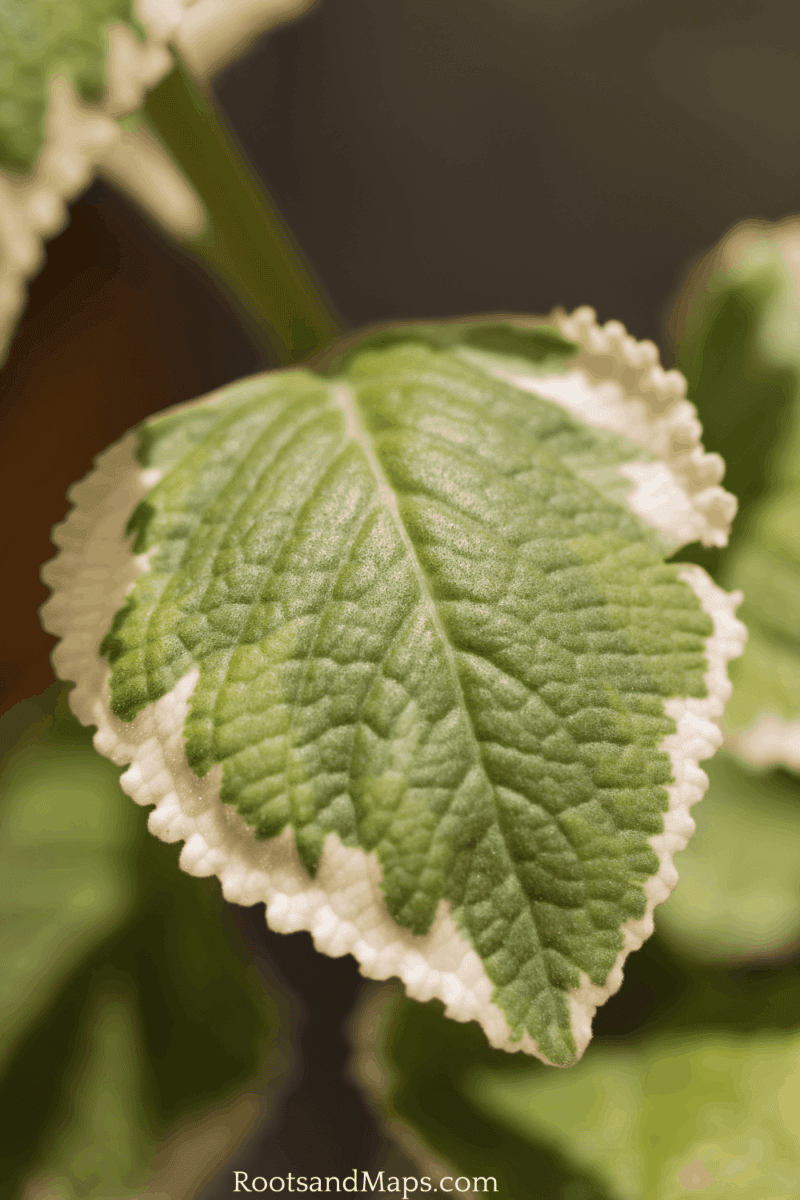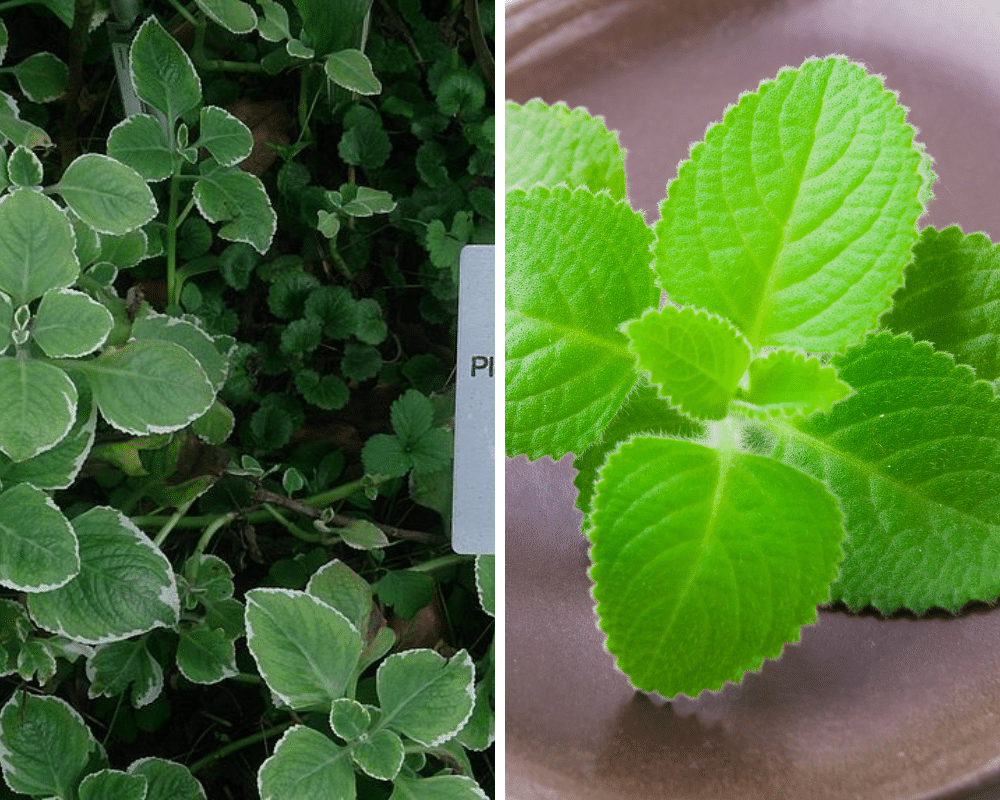
You will find the variegated version of Cuban Oregano to be pretty, practical, and tasty in the kitchen! Certainly, a beautiful plant; it is an herb in the Lamiaceae family, (that’s mint) so expect it to be fuzzy-leafed, aromatic, and semi-succulent. The plant is perennial in zones 10-11; treat it as an annual in colder climates with the bonus that it is shamefully easy to grow from cuttings to use indoors all winter. Tasty in the kitchen, it is useful in soups, sauces, marinades, and other dishes. If that’s not enough, it will discourage marauding rabbits and deer in the garden and is not appreciated by mosquitoes!
Variegated Cuban Oregano-Coleus amboinicus ‘variegatus’

Coleus is its Genus, which consists of annual or perennial plants, and shrubs, originating in the tropical and subtropical regions of Africa and Southeast Asia. The species name, amboinicus, refers to Ambon Island in Indonesia, the plant was discovered by Joao de Loureio (1717-1791). He was a man of many skills, a botanist, Jesuit missionary, mathematician, astronomer, physician, and world traveler when travel was risky.
Having spent many years in Asia, his masterwork was called the Flora Cochinchinesis, it was most likely the first botanical survey of Asian plants, emphasizing medicinal plants and covering 1600 species.
‘Plant Coleus for More and Better Plants.‘
What Makes The Variegated Cuban Oregano Different From The Regular Version?
Variegated Cuban Oregano has the same features as the regular type but it has two colors on its leaf rather than solid green leaf. The second difference is that the flavor and scent are slightly more pronounced in the variegated variety.

Variegation in plants means the leaves contain more than one color. (Occasionally this can include the stems and fruit.) They can be marked with blotches, dots, stripes, and edges. In Cuban Oregano the leaf is green and white variations, in some cases the leaf looks like a flower with a picotee edge, and the second color is an outline around the leaf. The green part can be medium to dark. You may also see a white sport (small genetic mutation) or leaves with pink on the edges.
Variegated Cuban Oregano-A Little Plant With Lots Of Names
Cuban Oregano is shown in older works as Plectranthus amboinacus but the Genus was changed to Coleus in 2019. Plectranthus is a Genus of about 300 species of plants that are often semi-succulent. With ongoing DNA research plants are seeing their classifications change and this one is no exception. Cuban Oregano’s names have always been controversial. Originally classified as Coleus, by Loureio in 1790 it was changed to Plectranthus in 1825 then back again to Coleus in 2019!
For more information on growing and cooking with herbs read this.
Why Plant Names Change
Originally, plants were named based on their appearance, but once we had access to DNA analysis we learned that plants that looked alike were not always relatives and we changed the names. The plan is that the number of changes in the future will slow down considerably as DNA analysis gives us a final result. As learning the botanical names is important in understanding and managing the plants this should save us a considerable amount of time.
For more information on this try ‘Latin for Gardeners.’
Common Names
The plant’s common names are just as complicated. Pretty and useful the plant traveled the world picking up names as it went along; Cuban Oregano is also called Indian Borage, Mexican Mint, Spanish Thyme, Caribbean Thyme, and Broadleaf Thyme. You can find more.
What Do They Call It In Havana?-French Thyme!
Try to remember that the plant is beautiful, useful, and simple! The plant is full of surprises for us but complicated it’s not.
Just Remember It’s Not Cuban And It’s Not Oregano!

We found it in Indonesia, it may be native to Africa, and it has worldwide popularity, primarily in warm climates where it is well integrated into the kitchen.
Why do we call it Oregano? The scent and flavor remind us of oregano so the name was used and it stuck. The oil in both plants contains carvacrol and thymol. Carvacrol is what produces the oregano smell and makes you think you are tasting pizza. It is used in the food industry as a natural preservative. (Thymol has similar features.) Smell the two plants and you will understand the connection!
‘Sage advice for Herbs, Oregano’
Variegated Cuban Oregano, Pretty, Practical & Tasty Garden To Kitchen
In The Garden
This is a pretty plant, fast-growing, with thick, rounded, and velvety leaves having toothed margins and appearing in pairs along the stem. In the ground, it can reach 3′ tall and it spreads along the ground. Grow it in part to full sun in well-drained soil. The plant is remarkably simple to grow and propagate but it does not grow in wet soil or standing water.
Ways To Use Variegated Cuban Oregano As An Ornamental Plant

- Plant it in front of taller plants as an accent, the color will set off other ornamentals.
- Use it in containers with other ornamentals or edibles
- Variegated Cuban Oregano is excellent in hanging baskets as a trailing plant and if you use them around your porch or patio the scent will reduce the number of mosquitoes.
- Break off a leaf and rub it on your skin, it is a popular technique when the mosquitoes are busy.
- Use the plant near more delicate plants that may be prey to deer and rabbits. It’s not perfect but it does work.
- Take some cuttings at the end of your growing season, they make a pretty house plant and you can use it for cooking and bring it outdoors in the spring.
The Value Of Variegated Plants In The Garden And Containers
Variegated plants of any kind will add a dramatic element to the garden, variegations will have the most impact when they can be seen from close up. Place them when they are easy to see, and use plants with variegations in planters, the front of beds, and in borders around walkways. You won’t miss them in these places. At a distance white and green variegations can look gray and yellow and green can have an overall appearance of yellow-green. Up close they will keep their distance. Use very large variegations if you will see them from far away.
Variegated plants will make the most dramatic impact when set against dark solids, shades of purple, dark green, or near black will add the most effect.
Use Variegated Cuban Oregano As A Groundcover

Fast-growing, Cuban Oregano, of both varieties, can serve as a ground cover. Keep in mind, the fact that while it will cover your space quickly, its life span as a perennial is about five years. Most other ground-covering plants take a good three years to provide complete coverage but they are much longer lasting.
Our garden is in zone 10 and we use it as an edging material where it is not difficult to add cuttings in any open spaces.
‘How to Find a Low Maintenance Ground Cover the Rabbits Won’t Love’
Use Cuban Oregano, Variegated Or Green, To Attract Pollinators
Deer, rabbits, and mosquitoes may avoid the strong scent of the plant but it will bring you both bees and butterflies. The flowers, in white, lavender, and pink will appeal to the pollinators. In our garden, we use it in an area dedicated to pollinators and allow it to flower. However, in the herb garden, we remove flower stalks as herbs tend to become bitter when the flowers arrive.
Impact On Deer And Rabbits
Wildlife will eat when they need to but they have preferences like the rest of us. Herbivores, especially deer use their acute sense of smell to find food and identify predators. They will avoid being near strong scents that obliterate their ability to find tasty shoots and protect themselves. Plants in the mint family have extremely strong scents and rough textured leaves. Deer and rabbits will avoid these strong smells if they can.
Plant Cuban Oregano, particularly the decorative variegated variety near your most tasty plants and you should be rewarded.
This is a good plant to grow on your patio near the kitchen. Here is how to grow herbs in containers.
Propagating Your Plant
Cuban Oregano, variegated or green is easy to propagate. The succulent stems will root easily and the plant is very sharable. It is a perfect ‘Pass Along Plant’ for your friends and neighbors.
- We cut a piece about 4-6 inches long, remove the lower leaves, and stick it in the ground, or water and transfer it to a container.
- If you allow your stems to trail along the ground they will root themselves.
- You will produce plenty of sprigs to cook with.
Uses For Variegated Cuban Oregano In The Kitchen
The general idea is to employ the oregano-like scent and flavor of the plant when you need an oregano scent. Why would you do that, instead of simply using true oregano which comes in a useful range of flavors? (This may be useful, ‘Oregano-Garden To Kitchen’.)

- Cuban Oregano has a stronger, more astringent flavor than true oregano; use it when you want to emphasize that fact. Good examples are Cuban dishes such as marinades and sauces for pork roasts and other traditional dishes. Use it in preference to true oregano for authenticity when making tropical meals.
- Start slowly, the Cuban oregano plant has a stronger flavor. Use it sparingly and taste.
- Use it in a blender to make marinades, and sauces or soups. Add it to flavors like onion, garlic, carrots, celery, tomato, and peppers.
- Cuban Oregano can stand up to strong flavors, use it with sage, rosemary, thyme, and bay leaf.
- Here you will find recipes for various dishes, chicken, pork, and even cocktails. Cuban Oregano.
Summary,
If you appreciate the aromatic scent o of oregano and its relatives and the woody and pungent flavors they produce you have several choices of herbs to grow for your kitchen.
Consider the various strengths of the flavors you can produce from your garden. You may choose to grow more than one for your kitchen. Here is a quick review of the herbs and their flavor profiles.
True Mediterranean Oregano
- Marjoram-Delicate, Sweet, and slightly bitter.
- Italian Oregano-Hybrid of oregano and marjoram, expect a sweeter flavor.
- Greek Oregano-Most common and most earthy flavor.
- Turkish Oregano-More pungent than Greek Oregano.
- Syrian Oregano-Expect a peppery note.
Oregano Flavor Alternatives
- Mexican Oregano- Related to lemon verbena the flavor is both pungent and slightly citrus-like.
- Cuban Oregano-Green- a strong scent and flavor
- Cuban Oregano-Variegated -we separate these because many gardeners and cooks consider this one to be the stronger of the two.
This suggests that the various sources of oregano flavor should be ranked from mildest to strongest with Marjoram as the mildest and variegated Cuban Oregano as the strongest.
If you grow and cook with any of them let me know what you think.
Resources You Can Use
Oregano, this will have more detail on the various versions of oregano.
Cuban Oregano, University of Florida
